Pressure Ridges
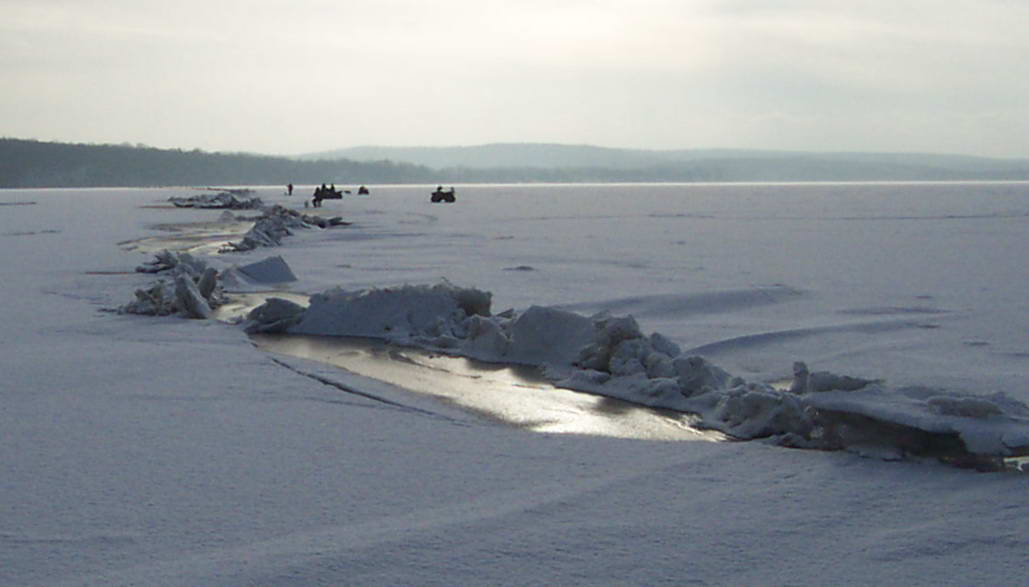 A classic pressure ridge. This one served as the border fence between the US and Canada in 2005.
A classic pressure ridge. This one served as the border fence between the US and Canada in 2005.
Summary: Pressure ridges are one of the best known ice hazards. There are two basic types: overlapped and folded. Folded ridges are harder to spot and account for a lot of swims. Driving over them accounts for a significant portion of vehicle mortality on ice.
Detail: Pressure ridges are compression ruptures that typically form as long cracks on ice sheets a mile or bigger in size. They typically come in when the ice is 2-4” thick, often as ice warms and expands as the cold spell that caused the ice to catch comes to an end. They generally run between points of land across the lake or across bay mouths. They also frequently form along the shore when the lake edge is too steep to push the ice sheet up onto the beach.
Pressure ridges are a very popular way to get in trouble, especially with vehicles. The ice in and near a ridge consists of broken and often poorly attached pieces. Plates held under water can erode significantly or even melt away completely. They come in a variety of variations and they are constantly evolving.
Ridges typically form after a cold spell comes to an end. (Click Here to see a video of an overlapped ridge coming in.) As the ice warms thermal expansion puts compression stress in the ice as it pushes into the shoreline around the lake. When the stress exceeds the compressive strength of the ice it ruptures. Points of land create stress risers that make it more likely that the rupture will occur there. They come in two major types.
- Overlapped ridges are the most common. They typically form abruptly, often with a loud bang or rumble as the ice ruptures. One side of the rupture climbs over the other. The ice sheet breaks into loose plates on each side of the center of the ridge. These extend from 1 to 15+ feet from the ridge center.
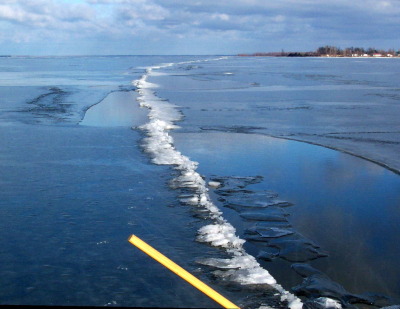
A small over/under ridge on 3-4" ice. Note puddles showing where the overlap switches sides.
- Folded ridges occur when the plates buckle rather than overlap. Their formation process is much slower, often deepening and lengthening slowly over several hours. They have water that is often several feet deep in the middle with the folded plates underneath. They are more difficult to see than overlapped ridges as their plates often stick up a few inches. As a result, they are especially common places for vehicles to go through. They often have a skim of ice on the puddle making them even trickier.
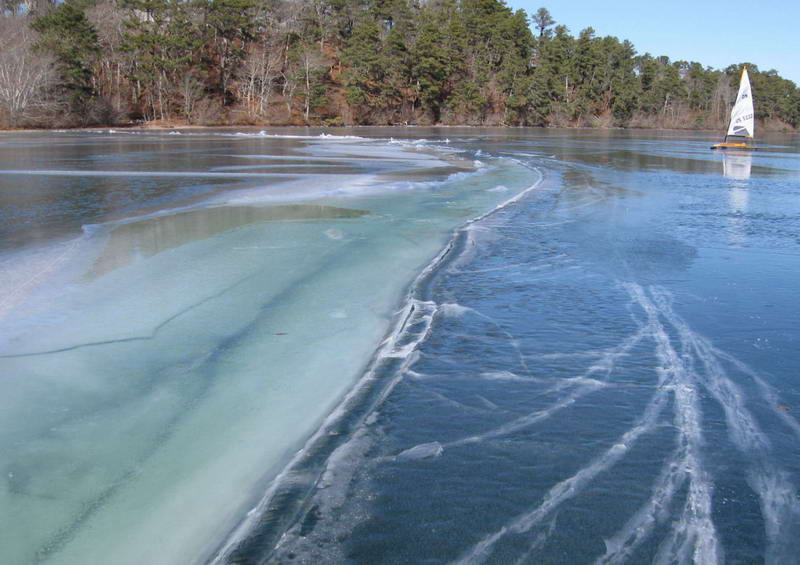 Classic downfolded ridge (left half of picture). Photo by Jeff Brown
Classic downfolded ridge (left half of picture). Photo by Jeff Brown
Folded ridges come in two variations: downfolded and upfolded. Downfolded ridges and they occur when the plates break and buckle downward leaving a deep puddle with ice underneath. Upfolded ridges are similar but the center is folded up and smaller puddles often occur on each side.
The puddle over the folded plates typically lengthens at a rate of a few feet to a few tens of feet an hour when the ice sheet is warming and growth stops when the heating stops (usually because the sun goes down). On the fast side we once saw one that progressed at walking speed until it got about 100 feet from an existing ridge. At that point the last 100 feet came in a couple seconds with an impressive bang. Downfolded ridges appear to be more common than upfoldded. The reverse is believed to be the case in Sweden (either something is lost in translation or one of us has it wrong)
Folded ridges often come apart within a few hours after they form. The plates float to the surface making a particularly treacherous condition (a loose plate ridge). The plates on overlapped ridges are typically better bound to the ice sheet so crossing them on foot is generally less dicey.
Short folded ridges often occur at the end of a longer overlapped ridge that terminates away from shore. If you walk to the end of the folded section (often a couple hundred yards or less) it will change into a tectonic crack which can generally be crossed easily.
Folded plates are pushed into warmer water so they will melt over time. Early in the season, before the water is fully cooled this happens faster.
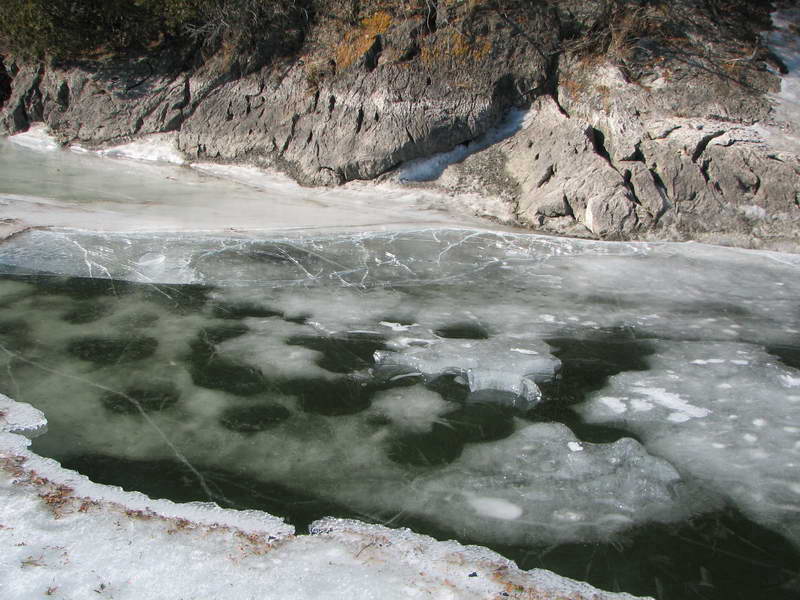 Eroded underwater plate of a downfolded ridge: Shelburne Pond, VT , December
Eroded underwater plate of a downfolded ridge: Shelburne Pond, VT , December
Folded ridges can occur in older ice, and are often snow covered making them especially hard to see. The single Vermont ice fatality in the 2013 season was on a snow covered, folded ridge. They can also be isolated from shore and other ridges. Sometimes these double ended, folded ridges can be very persistent. We had one of these ridges in 2012 on Shelburne Pond in Vermont that stayed active for the entire season.
Ridges may be a mix of overlapped and folded ridges although usually one type dominates.
General suggestions for crossing ridges:
- Don’t do it in vehicles.
- If you are on foot, have a buddy or two and everybody with throw ropes, test poles and ice claws
- Someone in the group should have with experience with crossing ridges.
- Folded ridges may be very difficult or impossible to cross however they often peter out in less than half a mile, alowing you to walk around the end.
- As you move along the ridge watch for hazards. The ridge zig/zags. You may also find wide wet cracks and even fairly large holes near a ridge. hazards like this are more likely near intersections of two ridges or more ridges.
- Most often the best prospects for crossing are where the ridge overlap switches sides.
- Often many of these ridge switches are less than ideal. Keep looking until you find a reasonable looking place. Use a test pole to check for thin ice and loose plates. There is often thin or no ice in the center of the ridge. At a good crossing this will be less than a few inches wide.
- Snow can hide ridges or obscure weak areas. Use your test pole a lot to check what is under the snow.
- Before crossing, use your pole to stab for thin spots and push hard for several seconds to test plate stability. If you can push a plate down, try somewhere else.
- A big step (generally sideways on skates) is often the best way to make the manoeuvre.
- Once across move promptly away from the crack in case the plate you are standing on is not as well attached as you thought it was.
- Be patient and be prepared to go back to shore if you can't find an acceptable crossing
- An iceboat can often be used as a bridge.
- Sailing across ridges is always a dumb idea. Sooner or later one of the runners will get stopped and you will break the boat and maybe yourself.
- Keep in mind that a ridge that was reasonable to cross in the morning may be a mess a couple hours later.
- Often ridges are gotten around by going ashore.
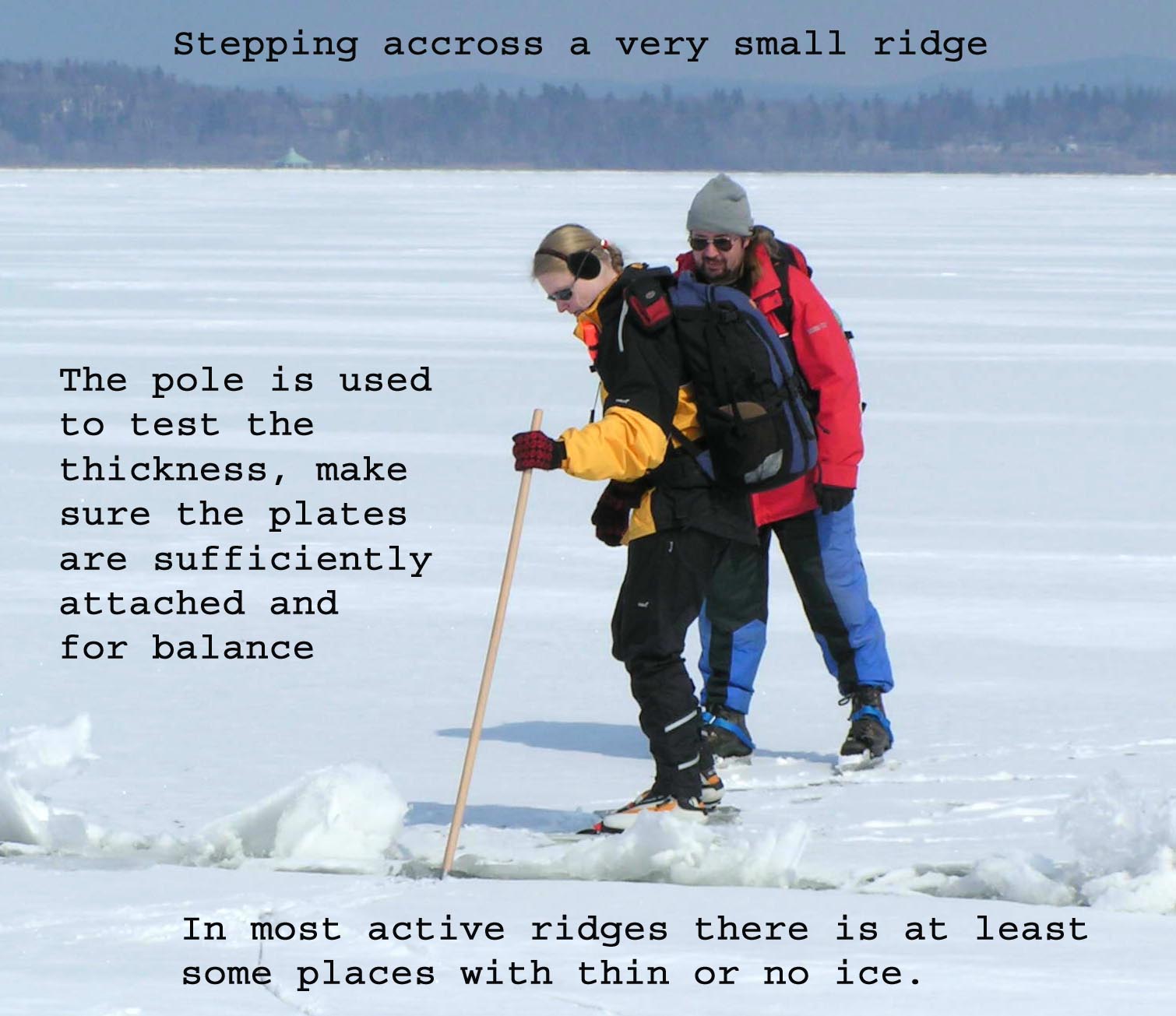
More on Pressure Ridges
